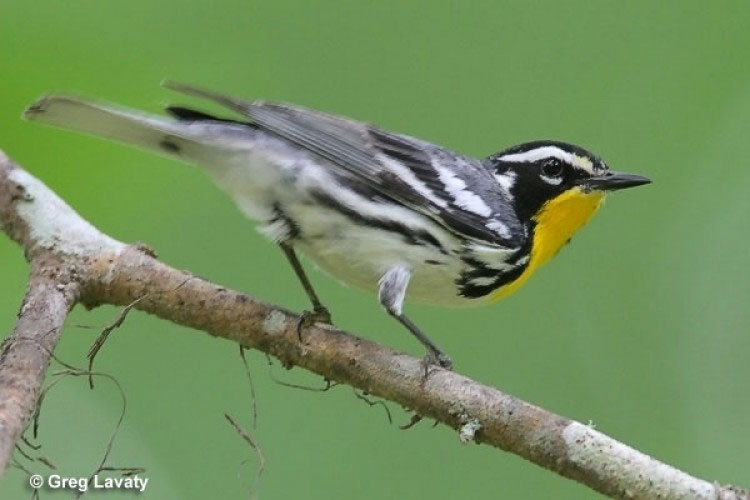The Yellow-Throated Warbler is a small stunning bird known for its distinctive bright yellow throat that stands out amidst the greens and browns of its forest home.
Found in the southeastern forests of the United States, this bird is a delight for birdwatchers and nature enthusiasts alike.
With its whistly songs and fidgety demeanor, the Yellow-Throated Warbler is a true joy to behold.
On this page
Identification
Male Yellow-throated Warblers have brighter plumage during the breeding season. Their upper parts and wings are gray, and their wings have double white wing bars. Their underside is white, and their flanks are streaked with black.
These birds can be distinguished by their bright yellow throats and black mask around their eyes, which includes a long white “eyebrow” running from the base of their bill above their eyes that ends at the back of their head.
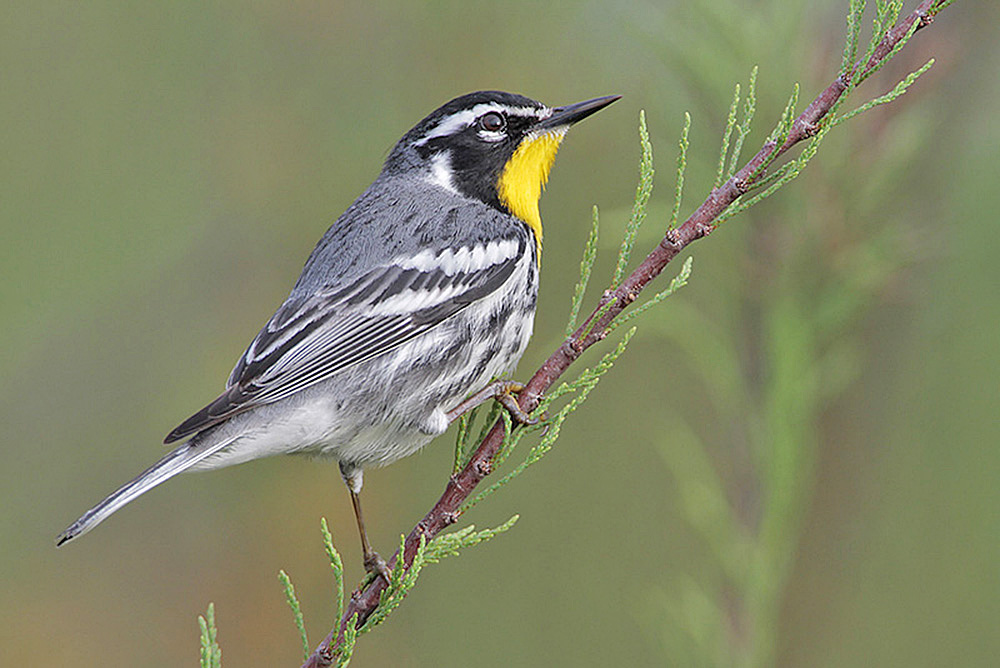
The song of a Yellow-throated Warbler is a series of clear whistle-notes that slightly drop in pitch, although it sometimes ends with a higher-pitched note. Only males sing. They also call with a loud and sharp chip.
Female Yellow-throated Warblers look quite similar to males, but their colors are duller and patterns less defined. In particular, the yellows are less bright, they have dark grey feathers instead of black ones, and the patterns on their head are not so well defined.
Females also don’t sing, but they do give high-pitched, loud, and sharp chip sounds.
Non-breeding males and immature Yellow-throated Warblers look the same as females – they have the same washed-out version of the bright plumage and patterns the breeding male does. However, all of them seem to be about the same size. They measure 5.1-5.5 inches in length, weigh around 0.3-0.4 ounces, and have a wingspan of 8.3 inches.
Food
Yellow-throated Warblers are almost entirely insectivorous, meaning they eat only insects, but they also munch on berries and drink nectar outside of the breeding season.
During the breeding season, you can see them creeping and hopping along branches near the top of the canopy or trunks, probing into crevices, coniferous trees’ needle clusters, and cones with their long bill. They feast on beetles, caterpillars, flies, moths, grasshoppers, mosquitoes, and crickets, but also on spiders and ants. Sometimes they also fly out to catch insects mid-air.
In the winter, after they’ve migrated to the tropics, they forage insects that are attracted to agave and coconut palm flowers. While foraging, they may even hang upside down among palm leaves to find insects.
Nesting and Eggs
Yellow-throated Warblers build their nests in the canopy of mature forests, preferably in Spanish moss or at the end of a branch. If there’s no Spanish moss, the nest is built on the edge of a high branch 30-60 feet above the ground. They prefer pines, cypresses, and sycamores.
Both sexes build the nest, but the female does most of the work. The nests built in Spanish moss are cup-shaped pockets that the female then lines with grasses, weeds, and feathers and weaves strands of moss into them.
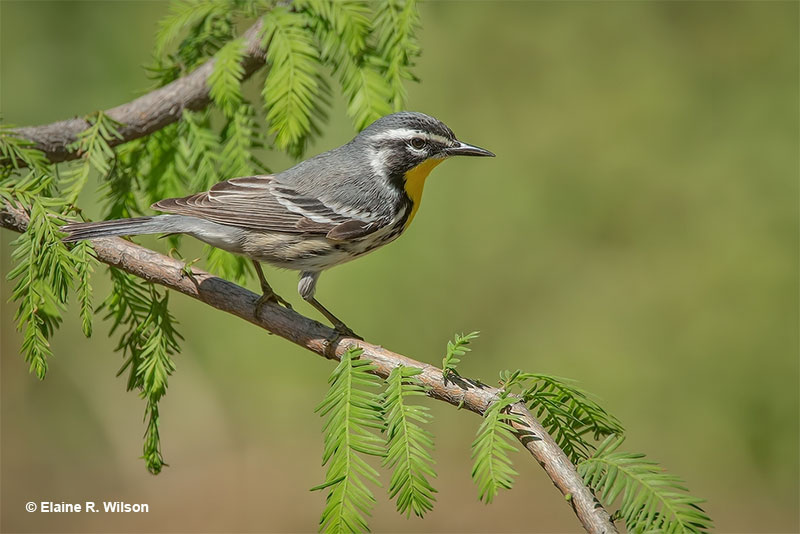
If the nest is built on a branch, then it’s an open cup that is weaved from strips of bark, grasses, caterpillar webs, and weeds. The female lines it with soft plant material and feathers.
Yellow-throated Warblers usually have 2 broods per year with 3-5 eggs in a clutch. The eggs are dull grayish white to pale greenish with dark purple, red, and brown specks and are 0.6-0.8 inches long and about half an inch wide. It takes 12-13 days to incubate them.
Since the sexes are so similar, it is difficult to say who incubates eggs and feeds the young, although it is presumed that the female does most of the incubating and both feed the young. The specifics of when the young fledge and how long they stay with their parents are also unknown.
Current Situation
You can find this warbler with a yellow throat in southeastern North America with their breeding range extending from southern Pennsylvania and northern Missouri to the Gulf of Mexico.
It’s a migratory species that moves to the Gulf Coast, eastern Central America, and the Caribbean in the winter. However, a portion of the population in northwest Florida stays put year-round.
They inhabit open woodlands and groves with an open understory, preferring coniferous or swamp trees that have Spanish moss.
They mostly breed in pine forests, bald cypress swamps, and woodlands with streams. During the winter they can be found in similar habitats but also in parks, gardens, and foraging in palm trees.
Yellow-throated Warblers are listed as a species of least concern in the IUCN Red List. Its population and range seem to be increasing with not much information available about the possible threats.
Facts
- Yellow-throated Warblers may copulate with Northern Parulas and the resulting hybrid is known as Sutton’s Warbler. The hybrid doesn’t have the streaked flanks the Yellow-Throated Warbler has and has a greenish-yellow back.
- Yellow-throated Warblers usually live for about a year or two. The oldest known individual lived to be 6 years and 10 months old.
Similar Species
Yellow-throated Warblers have three similar species. Some of them can be quite similar, so be sure to read on to learn how to differentiate between them!
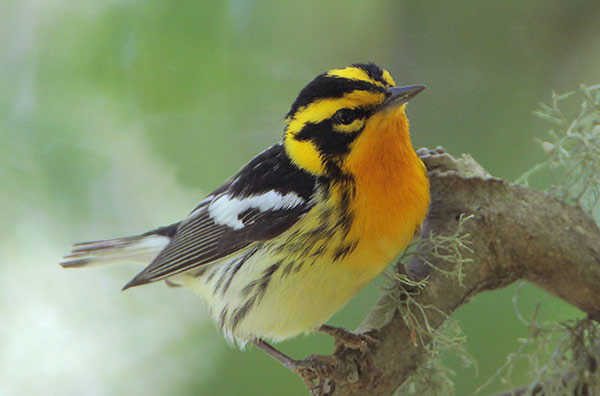
Blackburnian Warbler
Blackburnian Warbler – The male Yellow-throated and Blackburnian Warblers look very similar.
However, the Blackburnian Warbler has a bright orange throat instead of a yellow one, and the areas that would be white on a Yellow-throated Warbler’s face are orange on a Blackburnian Warbler’s face.
Blackburnian Warblers are also streakier and have black instead of the Yellow-throated Warbler’s gray plumage. Female and immature Blackburnians are more different.
They have much more yellow, including on the face and underside, and the plumage on their back is brownish streaked with yellow instead of gray.
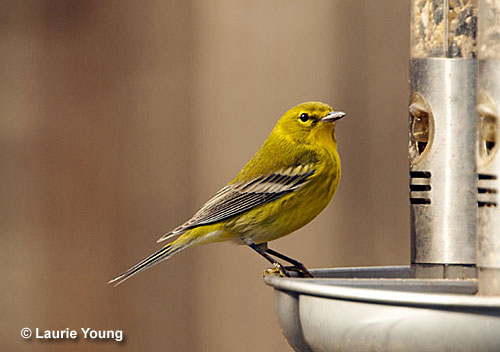
Pine Warbler
Pine Warbler – you might confuse the two at first if you see a flash of yellow at a distance.
If you take a closer look, then they’re quite different. Pine Warblers have an all-yellowish-green head, throat, back, and upper chest. They also lack the streaked flanks.
The females have a washed-out version of that plumage.
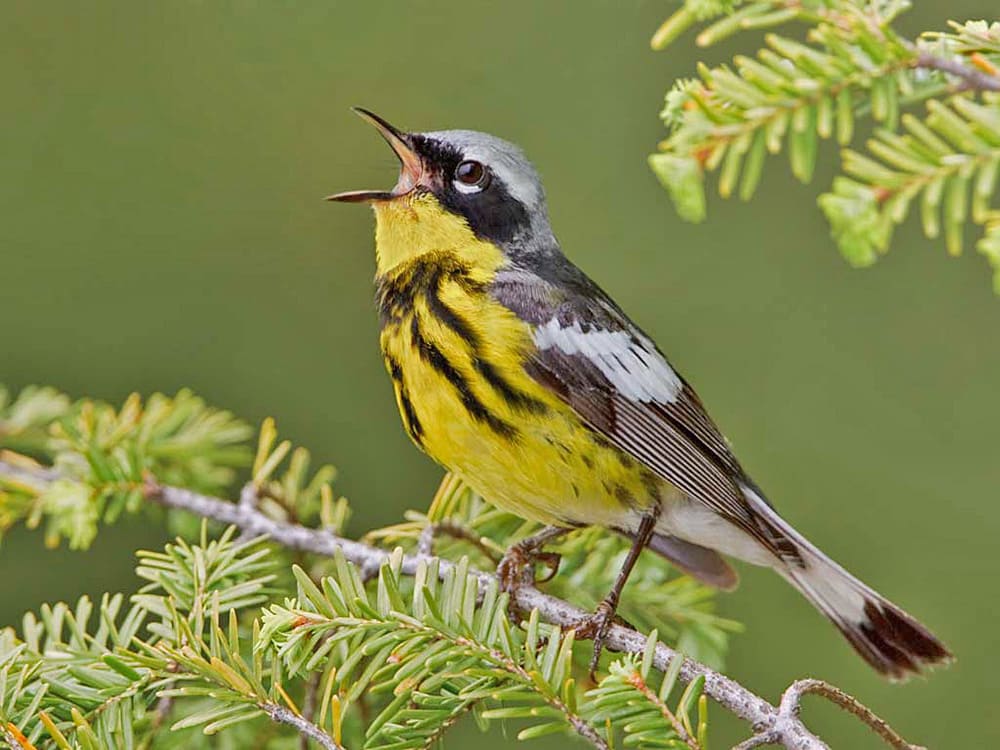
Photograph © Glenn Bartley.
Magnolia Warbler – Magnolia Warblers are also a mix of yellow, black, gray, and white.
However, the distribution of these colors is different.
Male Magnolia Warblers have a yellow chest and belly instead of a white one and they have a black “necklace”.
Their back is black instead of gray and their white eyebrow is very short.Female Magnolia Warblers look quite different.
They have a yellow underside and gray head and mostly gray upper side, so it shouldn’t be too difficult to tell them apart.
Question and Answers About Yellow-throated Warbler
Are yellow-throated warblers rare?
Yellow-throated Warblers are common within their range in the southeastern United States.
Where do yellow-throated warblers live?
Yellow-throated Warblers live in open woodlands with nearby streams, pine forests, and bald cypress swamps. You can often find them nesting in Spanish moss.
Do yellow-throated warblers migrate?
Yellow-throated Warblers migrate to the Gulf Coast, eastern Central America, and the Caribbean in the winter. A subspecies of them in northwest Florida stays put year-round.

